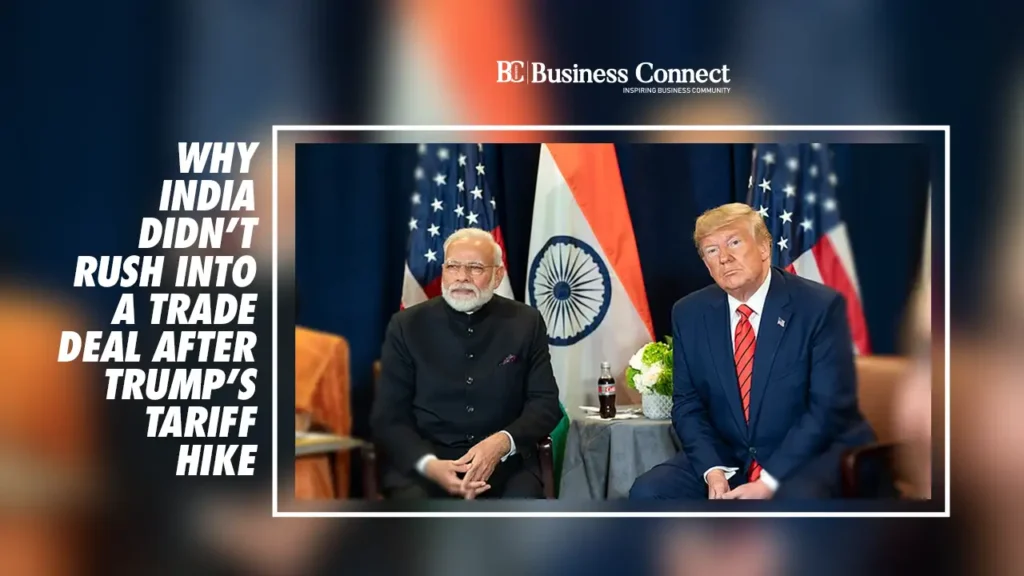Trump Slaps Steep Tariffs on Indian Imports—But Here’s Why New Delhi Isn’t Rushing Into a Deal: Business Connect Report
In a major trade move, U.S. President Donald Trump announced 25% tariffs on imports from India, along with an unspecified “penalty.” Despite this aggressive stance, India has remained composed, refraining from jumping into a quick deal with Washington.
Behind India’s Bold Stance on U.S. Tariffs: Protecting Farmers, Securing Sovereignty
While the U.S. has secured trade agreements with other countries—like Japan, which made concessions on American auto and agricultural market access—India has held firm. The Indian government is protecting its domestic interests, especially the agricultural sector, which supports millions of small-scale farmers and represents a significant voting demographic.
In a recent trade pact with the United Kingdom, India successfully shielded its sensitive agricultural sectors from tariff reductions, setting a precedent for similar negotiations with the U.S.
Carlos Casanova, Senior Economist at UBP, noted that India is not backing down because exports to the U.S. make up only a small portion of its economy. “India simply cannot afford to open its agricultural market to U.S. firms,” Casanova said. According to 2024 U.S. government data, American goods imports from India amounted to $87.4 billion.
India’s Commerce and Industry Minister Piyush Goyal, in an interview with Business Connect, emphasized India’s cautious stance. “We are always very sensitive to the interests of our farmers and MSMEs. We will make sure that our areas of concern are strongly protected,” he said.
Speaking on Sunday, Goyal also stressed that India does not operate on externally imposed deadlines. “While a trade agreement is desirable, national interest comes first. I’m confident that by the October–November 2025 timeline, we will arrive at a deal that benefits both sides,” he told The Economic Times.
Jayant Dasgupta, India’s former ambassador to the World Trade Organization, echoed these sentiments. “India’s red lines are clear—especially in agriculture, GMOs, and dairy. There’s no room for compromise on these fronts,” he told Business Connect.
Harsha Vardhan Agarwal, President of the Federation of Indian Chambers of Commerce & Industry (FICCI), acknowledged that the U.S. tariffs will impact Indian exports in the short term. However, he expressed optimism, stating, “We hope these duties are temporary and that both nations can soon finalize a permanent trade agreement.”
Analysts previously told Business Connect that the U.S. has strategic reasons to close a deal with India. “Washington views India as a critical ally in the Indo-Pacific region,” said Harsh V. Pant, Vice President of Studies and Foreign Policy at the Observer Research Foundation. “It cannot afford to alienate one of its strongest potential partners in the region.”
FAQs: Trump’s Tariffs on India and New Delhi’s Strategic Response
Q1: What has the U.S. government done recently regarding trade with India?
A: U.S. President Donald Trump has announced a 25% tariff on Indian imports, along with an unspecified additional penalty. This move is part of the U.S.’s broader trade strategy.
Q2: How has India responded to these tariff hikes?
A: India has chosen not to rush into a trade deal with the U.S. Instead, it is taking a cautious and strategic approach, prioritizing national interests over external pressure.
Q3: Why is India not immediately seeking a resolution?
A: India is protecting its sensitive sectors, particularly agriculture and MSMEs. These sectors are crucial to the Indian economy and voter base, and the government is not willing to compromise them for a quick trade deal.
Q4: What role do Indian farmers play in this decision?
A: Indian farmers are a significant political and economic force. The government wants to shield them from foreign competition, especially in the context of American demands for greater agricultural market access.
Q5: How significant are U.S. exports for India?
A: India’s exports to the U.S. make up a relatively small portion of its economy. In 2024, U.S. goods imports from India were valued at $87.4 billion—significant but not critical enough to make India vulnerable to tariff pressure.
Q6: What has Commerce Minister Piyush Goyal said about the issue?
A: In a Business Connect interview, Goyal emphasized India’s commitment to protecting farmers and MSMEs. He stated that trade deals should align with national interest and not be rushed under deadlines.
Q7: Has India made similar moves in other trade agreements?
A: Yes, India recently signed a trade deal with the UK where it successfully protected its agricultural sectors from tariff concessions, showing consistency in its trade strategy.
Q8: What are India’s non-negotiable areas in trade talks?
A: India’s “red lines” include agriculture, genetically modified foods (GMOs), and dairy. These areas are non-negotiable due to public health, food security, and livelihood concerns.
Q9: What is FICCI’s view on the situation?
A: FICCI President Harsha Vardhan Agarwal acknowledged the short-term impact of U.S. tariffs on exports but expressed hope for a balanced and permanent trade agreement in the near future.
Q10: Why does the U.S. still want a deal with India?
A: Strategically, India is a key partner for the U.S. in the Indo-Pacific region. Analysts believe Washington will avoid alienating India to maintain geopolitical balance and economic cooperation in the region.
Add Business Connect magazine to your Google News feed



